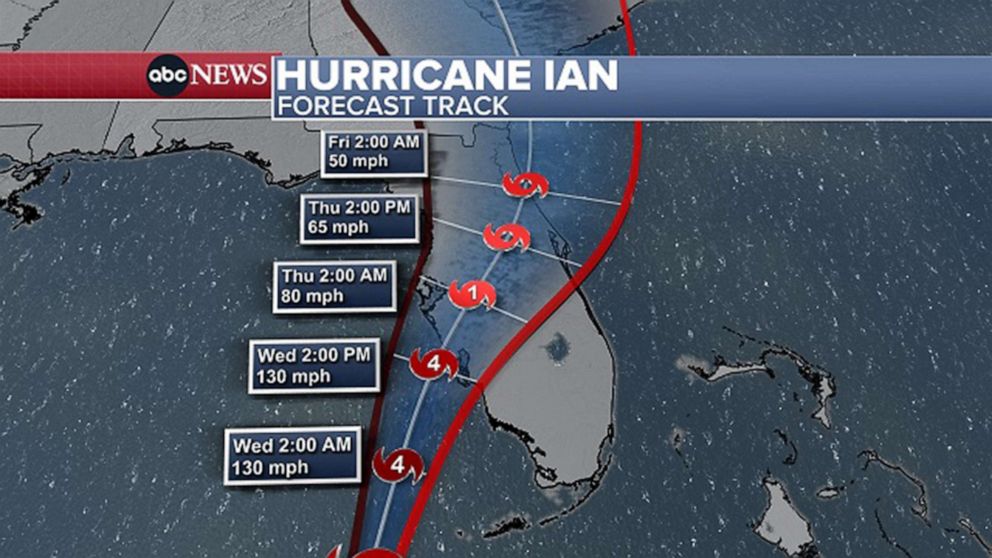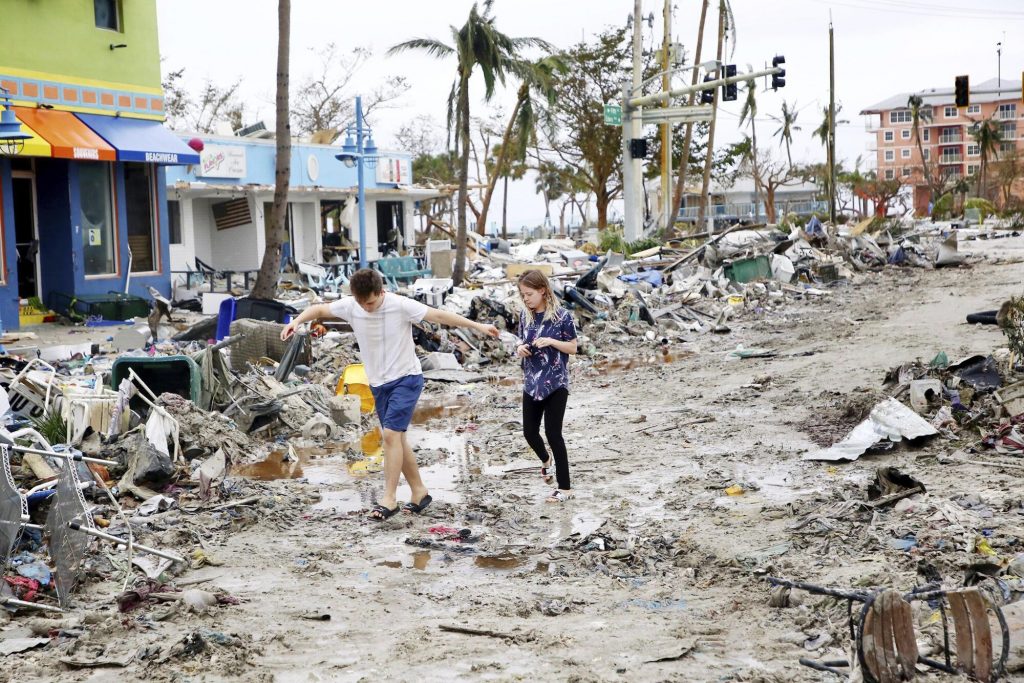Hurricane Ian’s Destructive Path: A Florida Peninsula Battered (September 28, 2022)

On September 28, 2022, Hurricane Ian, a Category 4 monster with sustained winds of 150 mph, etched its name into the annals of Florida’s hurricane history. The storm, which had undergone rapid intensification in the warm waters of the Gulf of Mexico, made landfall near Cayo Costa, an island off the coast of Fort Myers, bringing with it a catastrophic storm surge, torrential rains, and winds capable of pulverizing structures. Ian’s impact was far-reaching, leaving a trail of destruction across the Florida peninsula and impacting millions of residents.
Fort Myers Beach, a popular tourist destination known for its white-sand beaches and vibrant atmosphere, bore the brunt of Ian’s fury. The storm surge, a wall of water reaching heights of 12-18 feet, inundated the island, sweeping away homes, businesses, and landmarks. Videos and images captured the devastation, showing buildings ripped from their foundations and debris floating amidst a sea of churning water. The storm surge’s impact extended inland, flooding communities along the Caloosahatchee River and causing widespread damage.
As Ian moved across the Florida peninsula, it weakened but continued to unleash its destructive power. Heavy rains, exceeding 20 inches in some areas, triggered widespread flooding, transforming streets into rivers and inundating homes. Orlando, a city typically associated with theme parks and sunshine, experienced record rainfall and significant flooding, disrupting daily life and causing extensive damage. The storm’s winds, though diminished, remained strong enough to down trees and power lines, leaving millions without electricity.
The morning of September 27, 2022, dawned with a sense of foreboding for residents along Florida’s Gulf Coast. Hurricane Ian, having churned and intensified in the warm waters of the Gulf of Mexico, was now a Category 3 behemoth, its sights set on the Sunshine State. Mandatory evacuations were ordered for low-lying areas, and a mass exodus began as residents heeded the warnings, fleeing inland in search of safety. Those who remained, either by choice or circumstance, braced for the impending impact, boarding up windows, securing belongings, and seeking shelter in sturdy structures or local shelters.

As the hours ticked by, the storm’s outer bands began to lash the coast, bringing with them squalls of rain and increasingly strong winds. Fort Myers Beach, a vibrant tourist destination known for its white-sand beaches and lively atmosphere, transformed into a ghost town. Palm trees swayed violently, their fronds whipping in the wind, and the normally calm Gulf waters turned into a churning, angry sea. A sense of anxiety and uncertainty hung thick in the air as residents huddled indoors, listening to the howling wind and the relentless pounding of the rain.
By afternoon, Ian’s approach was undeniable. The sky turned an ominous gray, and the wind intensified, carrying with it the roar of the approaching storm. At approximately 3:05 pm, the moment residents had dreaded arrived. Hurricane Ian made landfall near Cayo Costa as a powerful Category 4 storm, its sustained winds of 150 mph capable of ripping buildings apart. The storm surge, a towering wall of water reaching heights of 12-18 feet, roared ashore, engulfing Fort Myers Beach and surrounding areas. Homes were lifted from their foundations and carried away by the raging waters, businesses crumbled into piles of debris, and landmarks that had stood for decades vanished beneath the waves.
The devastation on Fort Myers Beach was catastrophic. The once-idyllic island was transformed into a scene of utter destruction, a tangled mess of debris, destroyed buildings, and flooded streets. Rescue crews, braving the treacherous conditions, began the daunting task of searching for survivors and assessing the damage. Residents who had evacuated returned to find their homes gone, their belongings scattered, and their lives irrevocably changed.
As Ian moved across the Florida peninsula, it weakened but continued to unleash its fury. Heavy rains, exceeding 20 inches in some areas, triggered widespread flooding. In Orlando, a city known for theme parks and sunshine, streets became rivers, cars were submerged, and homes were inundated with water. The storm’s winds, though diminished, downed trees and power lines, leaving millions across the state without electricity and plunging communities into darkness.
The meteorological factors that contributed to Ian’s intensification were a combination of warm waters in the Gulf of Mexico, low wind shear, and a favorable atmospheric pattern. Sea surface temperatures in the Gulf were well above average, providing ample fuel for the storm’s growth. Additionally, wind shear, the change in wind speed and direction with height, which can disrupt hurricane development, was minimal. This allowed Ian to maintain its structure and strengthen rapidly. Finally, a steering pattern in the upper atmosphere guided Ian towards the Florida peninsula, setting the stage for a devastating landfall.

Ian’s impact extended beyond the immediate devastation of wind and water. The storm disrupted supply chains, leading to shortages of gasoline and other essential goods. The tourism industry, a vital part of Florida’s economy, suffered a significant blow, as hotels, attractions, and beaches were damaged or closed. The agricultural sector also experienced losses, with citrus groves and other crops impacted by the storm’s winds and flooding.
Meteorological Genesis and Escalation:
- September 23, 2022: A tropical wave emerges off the coast of Africa, embarking on a journey across the Atlantic.
- September 24-26, 2022: The tropical wave strengthens into a tropical depression and then Tropical Storm Ian, churning westward through the Caribbean Sea.
- September 27, 2022: Ian undergoes rapid intensification, exploding into a major hurricane as it enters the Gulf of Mexico’s warm waters. Florida residents brace for impact as mandatory evacuations are issued for vulnerable coastal areas.
Landfall and the Unleashing of Fury:
- September 28, 2022 (Morning): Hurricane Ian, now a monstrous Category 4 storm with sustained winds of 150 mph, takes aim at the Florida Gulf Coast. The atmosphere is thick with anticipation and dread as residents finalize preparations or evacuate inland.
- September 28, 2022 (Afternoon): At approximately 3:05 pm, Ian makes landfall near Cayo Costa, an island off the coast of Fort Myers. The storm surge, a towering wall of water reaching heights of 12-18 feet, slams ashore, engulfing coastal communities and causing catastrophic damage. Fort Myers Beach is particularly hard hit, with homes swept away, businesses destroyed, and landmarks obliterated.
Unfolding Devastation and Inland Inundation:
- September 28, 2022 (Evening): Ian continues its destructive path across the Florida peninsula, weakening but still packing a powerful punch. Heavy rains, exceeding 20 inches in some areas, trigger widespread flooding. Orlando and other inland cities experience record rainfall, transforming streets into rivers and inundating homes and businesses.
- September 29, 2022: The storm weakens further as it moves across central Florida and emerges into the Atlantic Ocean. However, its impact continues to be felt, with widespread power outages, disrupted infrastructure, and ongoing flooding.
The Wake of Destruction and the Road to Recovery:
- September 30 – October 2022: The full extent of the devastation becomes clear as floodwaters recede and search and rescue efforts transition to recovery operations. Communities across Florida face the daunting task of rebuilding homes, businesses, and infrastructure. The economic toll of the storm is staggering, with estimates exceeding $100 billion.
